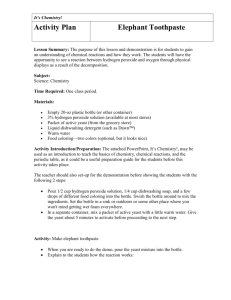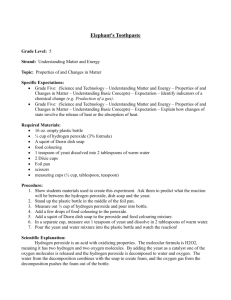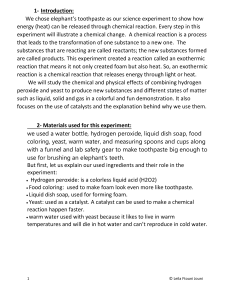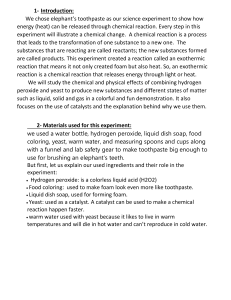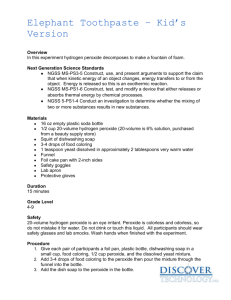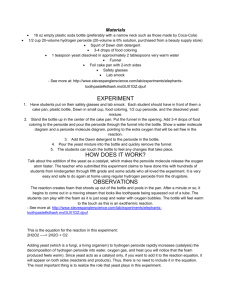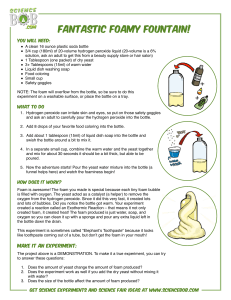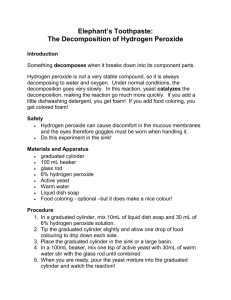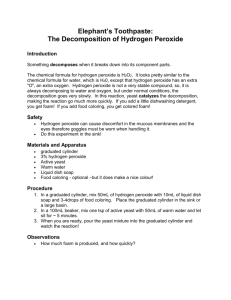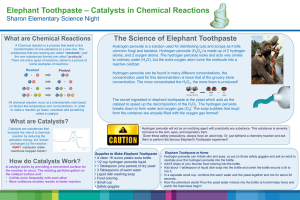Elephant Toothpaste
advertisement
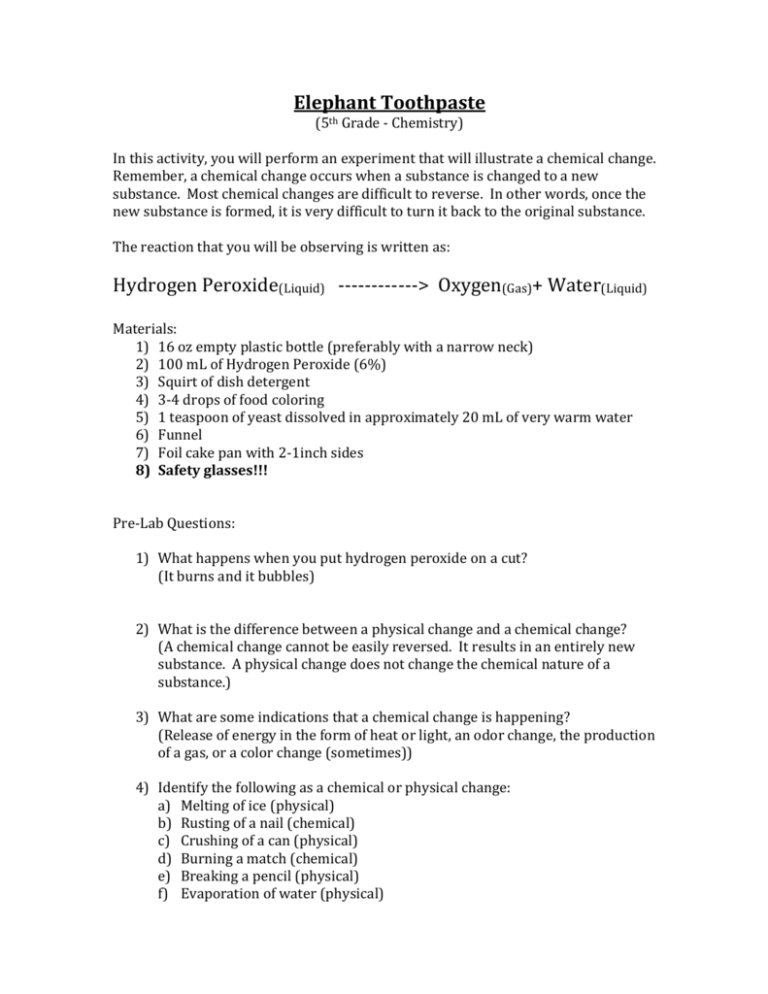
Elephant Toothpaste (5th Grade - Chemistry) In this activity, you will perform an experiment that will illustrate a chemical change. Remember, a chemical change occurs when a substance is changed to a new substance. Most chemical changes are difficult to reverse. In other words, once the new substance is formed, it is very difficult to turn it back to the original substance. The reaction that you will be observing is written as: Hydrogen Peroxide(Liquid) ------------> Oxygen(Gas)+ Water(Liquid) Materials: 1) 16 oz empty plastic bottle (preferably with a narrow neck) 2) 100 mL of Hydrogen Peroxide (6%) 3) Squirt of dish detergent 4) 3-4 drops of food coloring 5) 1 teaspoon of yeast dissolved in approximately 20 mL of very warm water 6) Funnel 7) Foil cake pan with 2-1inch sides 8) Safety glasses!!! Pre-Lab Questions: 1) What happens when you put hydrogen peroxide on a cut? (It burns and it bubbles) 2) What is the difference between a physical change and a chemical change? (A chemical change cannot be easily reversed. It results in an entirely new substance. A physical change does not change the chemical nature of a substance.) 3) What are some indications that a chemical change is happening? (Release of energy in the form of heat or light, an odor change, the production of a gas, or a color change (sometimes)) 4) Identify the following as a chemical or physical change: a) Melting of ice (physical) b) Rusting of a nail (chemical) c) Crushing of a can (physical) d) Burning a match (chemical) e) Breaking a pencil (physical) f) Evaporation of water (physical) Procedure: 1. Have students put on their safety goggles. Each group of students should have in front of them a cake pan, plastic bottle, dish detergent, food coloring, 100 mL of peroxide, and the dissolved yeast mixture. 2. Stand the bottle up in the cake pan. Put the funnel in the opening. Pour the peroxide through the funnel into the bottle. 3. Add 3-4 drops of food coloring to the peroxide. 4. Add a squirt of the dish detergent to the peroxide in the bottle. 5. Pour the yeast mixture into the bottle and quickly remove the funnel. 6. Record Observations. Record your Observations Below: (The reaction creates foam that shoots up out of the bottle and pools in the pan. After a minute or so, it begins to come out in a moving stream that looks like toothpaste being squeezed out of a tube. The students can play with the foam, as it is just soap and water with oxygen bubbles. The bottle will feel warm to the touch, as this is an exothermic reaction.) Conclusion Questions: 1) Based solely on your observation, what evidence is there that indicates that this reaction is an example of a chemical change. (Bubbles were produced and heat was generated) 2) Why do you think foam is formed? (The oxygen gas that is produced mixes with the dish detergent and creates the bubbles.) 3) What is yeast? (Yeast is a unicellular organism that is a member of the Kingdom Fungi) 4) How do we use yeast in our everyday lives? (Yeast is used to make bread rise and it is used to help make alcohol like wine) 5) What was the purpose of the yeast in this experiment? (Yeast produces a substance that speeds up the chemical reaction. Hydrogen peroxide eventually will turn to water and oxygen. In essence, it will go flat, like an open bottle of soda. The yeast just makes the reaction go quicker. 6) Select one material used in the experiment that could be altered to increase the amount of foam produced. (Increase the amount of yeast, Increase the concentration of hydrogen peroxide, increase the amount of hydrogen peroxide, etc…) 7) Design an experiment to test whether or not the altered material selected in question 6 would actually increase the amount of foam produced. See below: AMAZING TOOTHPASTE PLANNING SHEET My testable question is What is the effect of ____________________________________________ on ____________________________________________. My hypothesis is If ____________________________________________________________, then _____________________________________________________________ MATERIALS What one thing will I change on purpose? Scientists call this the independent variable or the manipulated variable _____________________________________________________________ _____________________________________________________________ How will I know if the one thing I changed on purpose made any difference? (How I will measure, observe, and collect data in the experiment). Scientists call this the dependent variable or the responding variable _____________________________________________________________ _____________________________________________________________ What things will I need to keep exactly the same in order to conduct a fair test? (Constants) _____________________________________________________________ _____________________________________________________________

